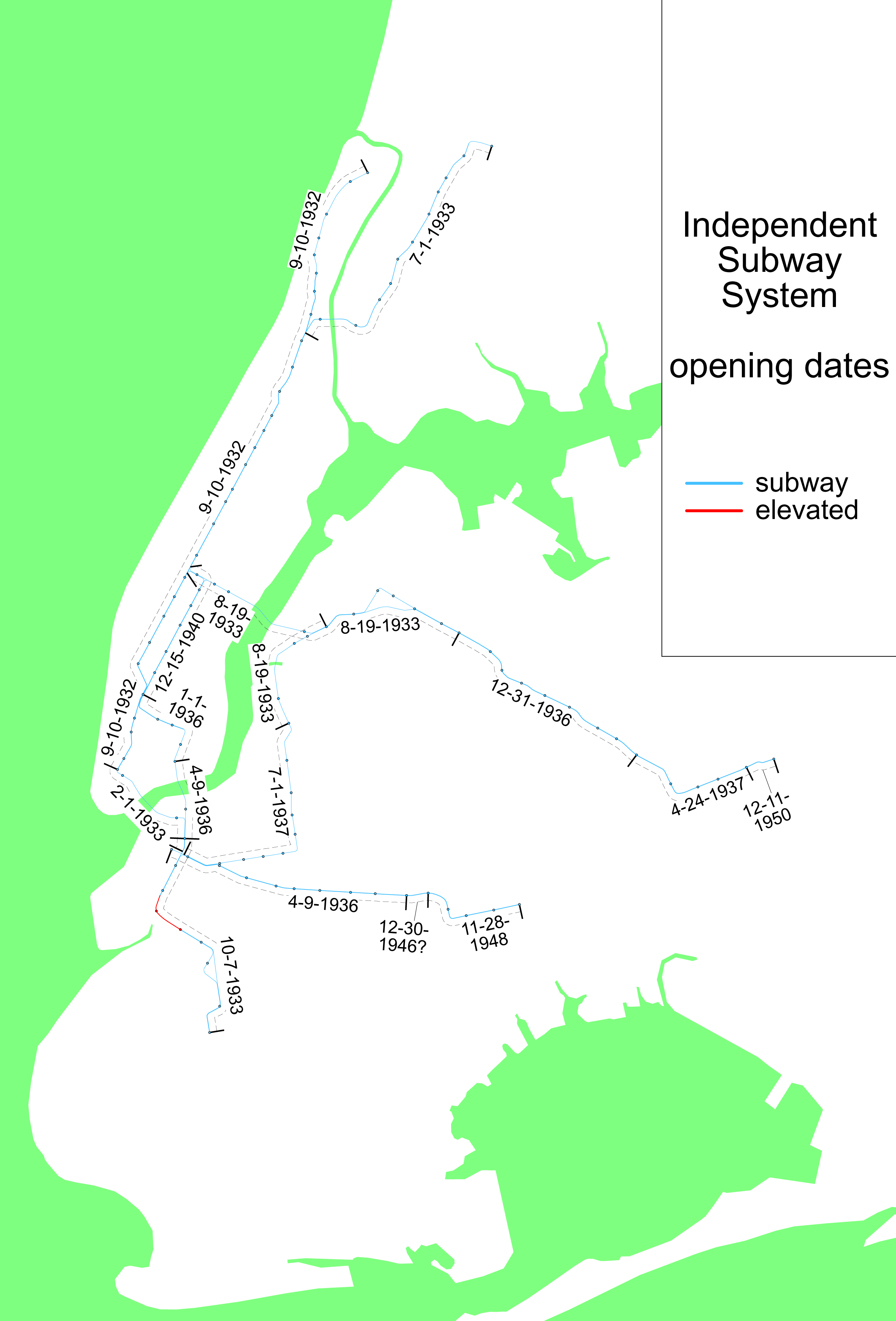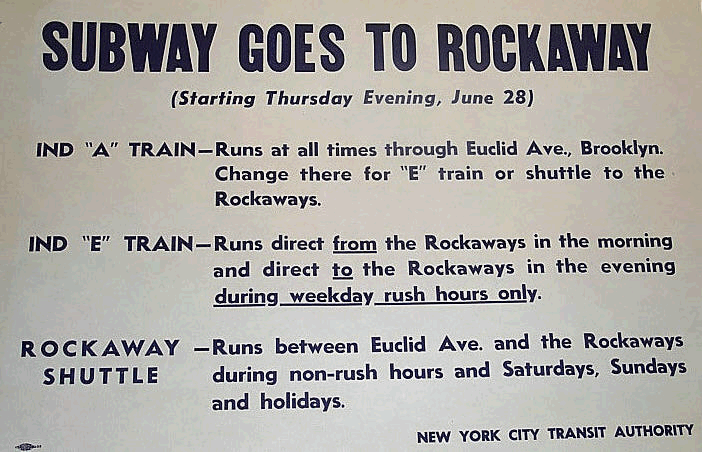|
Canal Street Station (IND Eighth Avenue Line)
The Canal Street station (formerly Canal Street– Holland Tunnel) is an express station on the IND Eighth Avenue Line of the New York City Subway. Located at the intersection of Canal Street, Vestry Street, and Sixth Avenue (Avenue of the Americas) in Lower Manhattan, it is served by the A and E trains at all times, and the C train at all times except late nights. History The station opened on September 10, 1932, as part of the city-operated Independent Subway System (IND)'s initial segment, the Eighth Avenue Line between Chambers Street and 207th Street. Construction of the whole line cost $191.2 million. Service at this station was provided with express service from its onset. On February 17, 1953, the New York City Board of Transportation installed two devices at either end of the station to alert police of passers-by above of emergencies in the station. The devices, which cost $1,100, were called "Call-a-Cop." In the station agent booth, an agent could set off an ... [...More Info...] [...Related Items...] OR: [Wikipedia] [Google] [Baidu] |
Manhattan
Manhattan (), known regionally as the City, is the most densely populated and geographically smallest of the five boroughs of New York City. The borough is also coextensive with New York County, one of the original counties of the U.S. state of New York. Located near the southern tip of New York State, Manhattan is based in the Eastern Time Zone and constitutes both the geographical and demographic center of the Northeast megalopolis and the urban core of the New York metropolitan area, the largest metropolitan area in the world by urban landmass. Over 58 million people live within 250 miles of Manhattan, which serves as New York City’s economic and administrative center, cultural identifier, and the city’s historical birthplace. Manhattan has been described as the cultural, financial, media, and entertainment capital of the world, is considered a safe haven for global real estate investors, and hosts the United Nations headquarters. New York City is the headquarters of ... [...More Info...] [...Related Items...] OR: [Wikipedia] [Google] [Baidu] |
Canal Street (Manhattan)
Canal Street is a major east–west street of over in Lower Manhattan, New York City, running from East Broadway between Essex and Jefferson Streets in the east, to West Street between Watts and Spring Streets in the west. It runs through the neighborhood of Chinatown, and forms the southern boundaries of SoHo and Little Italy as well as the northern boundary of Tribeca. The street acts as a major connector between Jersey City, New Jersey, via the Holland Tunnel (I-78), and Brooklyn in New York City via the Manhattan Bridge. It is a two-way street for most of its length, with two unidirectional stretches between Forsyth Street and the Manhattan Bridge. History By 1800, Collect Pond, one of New York City's few natural sources of fresh water, had become completely polluted with sewage and run-off from the tanneries, breweries, and other workshops and factories around it. Run-off from the pond, including one "sluggish stream" which traveled part of the route of the futu ... [...More Info...] [...Related Items...] OR: [Wikipedia] [Google] [Baidu] |
SoHo
Soho is an area of the City of Westminster, part of the West End of London. Originally a fashionable district for the aristocracy, it has been one of the main entertainment districts in the capital since the 19th century. The area was developed from farmland by Henry VIII in 1536, when it became a royal park. It became a parish in its own right in the late 17th century, when buildings started to be developed for the upper class, including the laying out of Soho Square in the 1680s. St Anne's Church was established during the late 17th century, and remains a significant local landmark; other churches are the Church of Our Lady of the Assumption and St Gregory and St Patrick's Church in Soho Square. The aristocracy had mostly moved away by the mid-19th century, when Soho was particularly badly hit by an outbreak of cholera in 1854. For much of the 20th century Soho had a reputation as a base for the sex industry in addition to its night life and its location for the headquarte ... [...More Info...] [...Related Items...] OR: [Wikipedia] [Google] [Baidu] |
Diamond Crossover
A railroad switch (), turnout, or ''set ofpoints () is a mechanical installation enabling railway trains to be guided from one track to another, such as at a railway junction or where a spur or siding branches off. The most common type of switch consists of a pair of linked tapering rails, known as ''points'' (''switch rails'' or ''point blades''), lying between the diverging outer rails (the ''stock rails''). These points can be moved laterally into one of two positions to direct a train coming from the point blades toward the straight path or the diverging path. A train moving from the narrow end toward the point blades (i.e. it will be directed to one of the two paths, depending on the position of the points) is said to be executing a ''facing-point movement''. For many types of switch, a train coming from either of the converging directions will pass through the switch regardless of the position of the points, as the vehicle's wheels will force the points to move. P ... [...More Info...] [...Related Items...] OR: [Wikipedia] [Google] [Baidu] |
Island Platform
An island platform (also center platform, centre platform) is a station layout arrangement where a single platform is positioned between two tracks within a railway station, tram stop or transitway interchange. Island platforms are popular on twin-track routes due to pragmatic and cost reasons. They are also useful within larger stations where local and express services for the same direction of travel can be provided from opposite sides of the same platform thereby simplifying transfers between the two tracks. An alternative arrangement is to position side platforms on either side of the tracks. The historical use of island platforms depends greatly upon the location. In the United Kingdom the use of island platforms is relatively common when the railway line is in a cutting or raised on an embankment, as this makes it easier to provide access to the platform without walking across the tracks. Advantages and tradeoffs Island platforms are necessary for any station with many th ... [...More Info...] [...Related Items...] OR: [Wikipedia] [Google] [Baidu] |
IND 8th Avenue Canal Street Exit Turnstile
Ind or IND may refer to: General * Independent (politician), a politician not affiliated to any political party * Independent station, used within television program listings and the television industry for a station that is not affiliated with any network * Independent Subway System, a former rapid transit rail system in New York City that is now part of the New York City Subway * International Nurses Day, celebrated in early May of each year to mark the contributions nurses make to society Science and technology * Improvised nuclear device, theoretical illicit nuclear weapon * IND, the Index control character in the C0 and C1 control codes * Individualism Index, a measure of a person's independence from organizations or collectivity * Induced representation, in mathematics, an operation for passing from a representation of a subgroup to a representation of the group itself * Indus (constellation), a constellation in the southern sky * Investigational New Drug, an ex ... [...More Info...] [...Related Items...] OR: [Wikipedia] [Google] [Baidu] |
New York City Board Of Transportation
The New York City Board of Transportation or the Board of Transportation of the City of New York (NYCBOT or BOT) was a city transit commission and operator in New York City, consisting of three members appointed by the mayor. It was created in 1924 to control city-owned and operated public transportation service within the New York City Transit System. The agency oversaw the construction and operation of the municipal Independent Subway System (IND), which was constructed shortly after the Board was chartered. The BOT later presided over the major transfers of public transit from private control to municipal control that took place in the 1940s, including the unification of the New York City Subway in 1940. In 1953, the Board was dissolved and replaced by the state-operated New York City Transit Authority, now part of the Metropolitan Transportation Authority (MTA). History Background In 1874, the New York State Legislature passed a bill allowing for the creation of a rapid ... [...More Info...] [...Related Items...] OR: [Wikipedia] [Google] [Baidu] |
Independent Subway System
The Independent Subway System (IND or ISS), formerly known as the Independent City-Owned Subway System (ICOSS) or the Independent City-Owned Rapid Transit Railroad (ICORTR), was a rapid transit rail system in New York City that is now part of the New York City Subway. It was first constructed as the Eighth Avenue Line in Manhattan in 1932. One of three rail networks that became part of the modern New York City subway, the IND was intended to be fully owned and operated by the municipal government, in contrast to the privately operated or jointly funded Interborough Rapid Transit Company (IRT) and Brooklyn–Manhattan Transit Corporation (BMT) companies. It was merged with these two networks in 1940. The original IND service lines are the modern subway's A, B, C, D, E, F, and G services. In addition, the BMT's M, N, Q and R now run partly on IND trackage. The Rockaway Park Shuttle supplements the A service. For operational purposes, the IND and BMT lines and service ... [...More Info...] [...Related Items...] OR: [Wikipedia] [Google] [Baidu] |
C (New York City Subway Service)
The C Eighth Avenue Local is a rapid transit service in the B Division of the New York City Subway. Its route emblem, or "bullet", is since it uses the IND Eighth Avenue Line in Midtown Manhattan. The C operates at all times except late nights between 168th Street in Washington Heights, Manhattan, and Euclid Avenue in East New York, Brooklyn, making all stops along its entire route. During late night hours, the train, which runs express along the entire C route during daytime hours, makes all stops. Historically, most C service ran only during rush hours, along the IND Concourse Line to Bedford Park Boulevard in the Bronx and later along the IND Rockaway Line to Rockaway Park–Beach 116th Street in Queens. Prior to 1985, the local C service was referred to as the CC, with the C designation reserved for a complementary express service that was discontinued in 1949. The CC was once the only route to serve the Bronx, Manhattan, Brooklyn, and Queens in a single trip. Outs ... [...More Info...] [...Related Items...] OR: [Wikipedia] [Google] [Baidu] |
E (New York City Subway Service)
The E Eighth Avenue Local is a rapid transit service in the B Division of the New York City Subway. Its route emblem, or "bullet", is blue since it uses the IND Eighth Avenue Line in Manhattan. The E operates at all times between Jamaica Center–Parsons/Archer in Jamaica, Queens, and the World Trade Center in Lower Manhattan; additional service during weekday rush hours originates and terminates at Jamaica–179th Street instead of Jamaica Center–Parsons/Archer. Daytime service operates express in Queens and local in Manhattan; late night service makes local stops along its entire route. E service, which is one of the most heavily used services in the subway system, started in 1933 with the opening of the IND Queens Boulevard Line. In its early years, the E train ran along the Rutgers Street Tunnel and South Brooklyn Line to Brooklyn, though this service pattern stopped by 1940. Until 1976, E train ran to Brooklyn and Queens via the IND Fulton Street Line and IND Roc ... [...More Info...] [...Related Items...] OR: [Wikipedia] [Google] [Baidu] |


_OSM_map.png)


.jpg)


